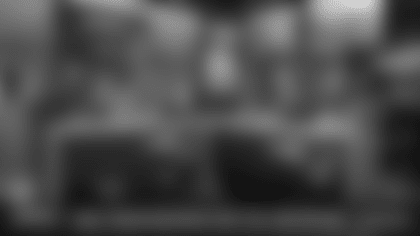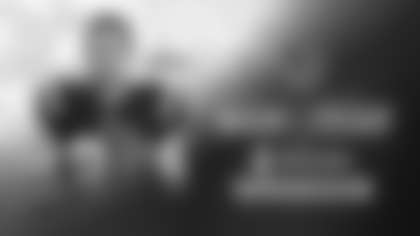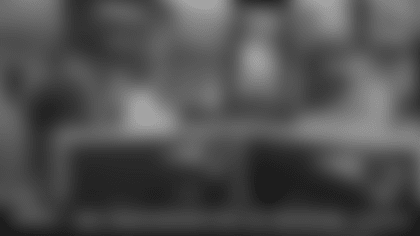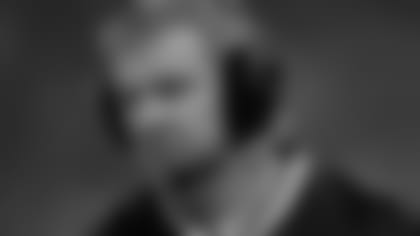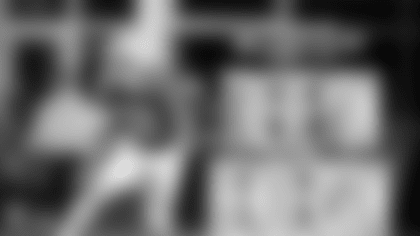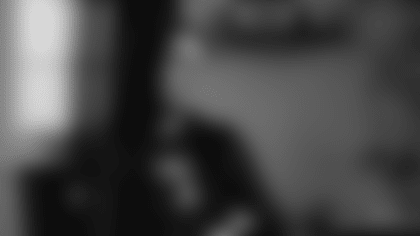Patriots head coach Bill Belichick addresses the media during his press conference at Gillette Stadium on Friday, November 5, 2010.
BB: How are we doing today? Good, Cleveland, Cleveland, that's about it. [It's] November, it's getting into real football weather here. No telling what we'll get there, or here, for that matter, the rest of the season, so, you have to be ready for anything. But, we're just trying to pull it all together. [The Browns are] a team we haven't played in a while. [There are] new faces, new schemes, just a lot of different looks that we have to prepare for here, so hopefully we can have a good day reviewing today, get it tightened up, and be ready to go on Sunday.
Q: Are you guys practicing outside today?
BB: We are.
Q: Is that why practice is outside today, just because you don't know what you'll get in Cleveland?
BB: Yeah, just kind of hate to be out there on wet fields. It didn't look like it was too good yesterday, but part of me wishes we would have been out there yesterday. But, no, we will be out there today. Whatever it is, it is. We'll deal with it.
Q: In your coaching career, was there anyone that you learned that from? The idea of 'you never know what you're going to get, so let's practice outside.' Does that come in handy later in the year?
BB: When I first started coaching, there were no indoor options. At the Colts, we were either in Memorial Stadium, which wasn't a great practice facility because they sodded the infield after baseball season, and that area was all roped off. So, you couldn't practice at that end of the field. You had to practice at the other end. Or the other option was you could push the walk button and walk the team across the street to Eastern High School. On the field there - I'd say it was two percent grass and 98 percent dirt and glass and rocks - and practice over there. So that's what it was. There was no indoor facility at Denver. There was no indoor facility at the Giants. We practiced every day, obviously, outside - [like in] training camp. So, the world of the NFL now is a lot different than what it was.
Q: Is it a little softer?
BB: Little bit, in some ways, in some ways. But I thought that at the Giants, we practiced in pads almost all the time, practiced in the stadium a lot. And Bill [Parcells] was definitely a big believer in whatever it is, it is. So, there [were] a lot of days where you didn't even think about; no matter what it was, you knew you were practicing in it; it didn't make a difference what it was. Which, you know, that's not a bad mentality to have because that's what it is on Sunday: whatever it is, it is.
Q: Speaking of taking ideas from other coaches, when you first decided that you wanted to pursue coaching, did you ever find yourself looking at other guys and taking ideas?
BB: Sure. I grew up in a coaching family and I had a great opportunity as a kid to see... you know, Navy had some very good football teams in the early 60s and some not so good [teams] after that, but there were a lot of great coaches that came through there. In addition to that, my dad ran a football camp in the summer for three weeks, the Chesapeake Football Camp, and he invited other coaches - not just the Navy coaches, but coaches at Maryland, Penn State, Pittsburgh, Virginia, in that area - to come to the camp. So I not only knew a lot of the Navy coaches or got to observe them or watch them in practices and meetings and so forth in my dad's football camp, [but it] was a great opportunity to see a lot of coaches coach. Everybody had their own different style and you look at some coaches and you see strengths or weaknesses or different methods of doing the same thing - sometimes equally as effective, but totally different - as opposed to just being locked into one coach. I guess I was fortunate - well, it was interesting, because when I was in high school, we had a real good high school program with Coach [Al] Laramore, who was a legendary Maryland coach and Hall of Fame coach and all that, and we had four plays. Literally, we had four plays - that's it. We had the same punt return. We had the same kickoff return. I mean, there were two defenses: split-six and gap-six. So I mean, you could put in the whole thing in, I'd say, 10 minutes - literally, 10 minutes. And then, when I went to [Phillips] Andover, we had really a great team there; we were 8-0 and New England Champions and all that. We had a bunch of plays and the quarterback called his own plays, and there was structure, but it was a totally different structure, which was the way it was with [Coach Ted] Marchibroda in Baltimore. Bert Jones was a young quarterback and Bert called his own plays. Today, I think that would be pretty much unheard of. It would be the most critical situation in the game, it would be third-and-two, and there would be a timeout, Bert would come over to the sideline and I'd stand over there with Ted, Bert, and Whitey Dovell, the line coach, and kind of listen in on the conversation and Ted would say, 'Well, we got 36-bob, we got 24-hunch, we got a pass-136 y-flag and we got the boot.' And it was just, 'Whatever you feel good about Bert,' and he'd go back out on the field and everybody was looking at him like, 'Alright, well, what are we going to call?' 'Well, I don't know, whatever Bert calls - that's what'll be.' So there are a lot of different ways to do it, that's the bottom line. I think you learn something ... I've learned something from every player I've coached; I think I've learned something from every coach that I've had an opportunity to observe or coach with and I'm sure that's true in reverse.
Q: Who do you look at now to exchange ideas with? Are there any younger coaches?
BB: You talk to a lot of people. It depends on what kind of information you're looking for. If it's another team or someone that's familiar with that team or a player and they're familiar with that player, that's one thing. And if they're not, or it's something that - I won't say they can't help you with - but they're not as familiar with as somebody else, then, [it's] just like you. Who do you ask the questions to? Somebody to give you the answers you're looking for. So, it's kind of the same thing - it depends on what you're after.
Q: Are you still refining practice schedules and techniques and drills?
BB: You do that all the time. Absolutely, we do it all the time. That's one of the great things about going out in spring, going to talk to Coach [Nick] Saban or Coach [Urban] Meyer, wherever the travels take you to - Will Muschamp at Texas, you can just go right down the line - Al [Groh] when he was at Virginia - whatever it happens to be, and see how they do things; see how they break up practice. Like before the Atlanta [preseason game], going over to Georgia Tech with Coach [Paul] Johnson and just actually watching a practice. I mean, how many practices do I get to watch, other than my own? Maybe one, two a year - that'd be a lot. It is just interesting to watch somebody else run their practice, how they set up the drills, how they break it down time-wise, [and] different things like that. So, that's good. A lot of times you talk to people about that and say, 'Hey, how do you handle this? How do you handle that?' And they tell you, but a lot of times you don't actually get to see it, so I think there's a lot of value in that. So it is interesting, but I think it's an ongoing process. You are always looking for better ways to do things and [figure out] how you can best teach and instruct your players and team most efficiently, and we are always striving to improve that. We talk about it every year. I mean, we talk about it multiple times during the year, too. We talk about it every year - what's our meeting time? How do we break that up? What's our practice time? How do we break that up? What's our walk-through time? When do we watch film? How do we do that? How can we do it better? Should we do it more together? Should we do it in different groups? Should we change the structure of the groups? How much should players watch by themselves? How much should they watch with the coach? How much should they, you know, all those different kinds of things. And maybe it's not the same for the receivers as it is for the linebackers or whatever. But that's a continuous self-evaluation that you do as a team to try and find the best way to do things.
Q: Following in the theme of looking back, when you look at your Cleveland years, do you look back fondly?
BB: Yeah, there are a lot of things you think about. From a football standpoint, I definitely think about the coaching staff. You look at the coaches that were there from Nick [Saban] to Kirk Ferentz to Pat Hill, Al Groh, - you can go right down the line - Woody [Widenhofer], Rod Dowhower - all the coaches - [Scott O'Brien], Ernie [Adams], and then the personnel people: Mike Lombardi, [Phil] Savage, and [Jim] Schwartz, Tom Dimitroff's dad, [Tom Dimitroff, Sr.], Dom Anile, Ozzie Newsome - it is a long list of people who have done very well in various areas of professional and college football - really outstanding. It was quite a collection of coaches that, again, I learned a lot from. They did a great job for me and watching them coach and interacting with them, I learned a lot about some of the things that they were doing. Also, we collectively talked about how to do things better as a staff. So that was good. We didn't have a very good team when we got there. We had a real good team by '94. 1995 was a bad year, but I don't think it was a bad team. So, I accept that. Could it have been better? Sure. Did I learn a lot? Yeah, I learned something every year. The whole personnel side of it, though, was a lot more than I had done with the Giants so that was - again, working with those personnel guys, a lot of the names I just mentioned - but that was another real good experience, Scott Pioli, obviously, all those guys. It started and grew and built to bigger and more expansive things. It really all started there.
Q: What are your feelings about going back to Cleveland?
BB: So many things have changed. The team that was there moved to Baltimore, so it isn't even that team. It was an expansion team that then became the new Cleveland Browns, if you will. There's not a lot of carryover from there. But there were a lot of good things there. The fans are very passionate. They're great. Football's their life: their high school football, college football, professional football, the Bengals, the Browns, the Hall of Fame is right there in Canton. There is a lot of football right there in Ohio. It's not an afterthought; it's a way of life. So that part of the culture is great. [There were] a lot of positives in that experience - I learned a lot and it helped me do some other things better in my career later on.
Q: How has Logan Mankins looked after a couple of practices?
BB: He looks alright. I think he's got a ways to go, as you would expect. He looks like he is in pretty good condition and Logan's a smart guy. He works hard, so that's never really an issue. He's just got to get better at doing things he hasn't done in a while.
Q: Is he ready to start on Sunday?
BB: Let's take it day-to-day here. We had a good day yesterday in terms of contact, padded and all that, and [we'll] see how things are today and take a look at it tomorrow. A lot of times it is the day after or two days after with players who are coming back, whether it's with injuries or, in this case, he wasn't here or whatever it happens to be, where the more days or the more time you have, I think the better you feel about the situation - one way or the other, whichever way it goes. To bring him onto the roster, we'd have to make a move, so that's a decision. So I think you take that as long as you can until you make the decision or until you know what the decision is and then make it. But I think you want to make the right one. You don't want to make a mistake on that, so we'll see how it goes here.
Q: NFL Films announced their top 10 football players of all-time, do you have any thoughts?
BB: Well, no, I don't really know how they went through the process. But I have a great relationship with Jim Brown. He was a big part of my experience in Cleveland. That was really, I'd say, one of the true highlights: the opportunity to talk and get to know him and become friends with Jim and have his perspective and friendship on a lot of levels. He is just a tremendous person, and of course, when you're real close to that situation, you start to have a little more appreciation of him as a player than even I did as a kid, as a fan, watching him. You go back and really talk to him and understand and that guy - he's a man's man now. He is so impressive in everything - not just as a player, but his physical presence, his competitiveness playing golf with him and stuff like that. He is very competitive, focused, and has a great winning attitude and I definitely learned a lot from him. Jerry Rice is kind of the opposite of that. I don't really have any kind of relationship with Jerry other than playing against him. Obviously, he was great player and great receiver and [part of] an offense that was very productive. We had some great battles with them; the 49ers and Jerry, they had some plays and some games against us that I am sure they are happy about and we had plenty against them that we did well in. It was a great competitive rivalry between the two teams, and Jerry Rice and Lawrence Taylor are probably two of the real - I mean, there were a lot of great players on both those teams, don't get me wrong - but those were really two of the great players of that era that matched up on respective sides of the ball and added a lot of excitement to the game and the matchup. Two great players. I don't even know who all the other ones are, but I am sure you can make a case for a lot of guys, but [there is] no doubt those two were pretty special.
Q: Did you see the list?
BB: No I didn't.
Q: Taylor's third. Joe Montana's fourth. Do you think there are 20 players better than Tom Brady in history?
BB: Well when you get into the Hall of Fame conversations, what's the criteria? Is it an outstanding season? Is it the longevity of the career? Is it a stat thing, which a lot of times it is versus what some players do that aren't in stats. They are hitting values. Just how do you want to measure it? Probably all those 20 guys, you can probably take more than that and make a case for a lot of them. It just depends on what your criteria is, which I don't even know what it was.
Q: What would be your criteria?
BB: I don't really have any criteria. I appreciate all of them and all their different roles. But to me, what difference does it make? Whether the guy is first or third or fourth, they're all pretty special. In all honestly, I've spent a lot more time thinking about the Browns, trying to get ready for Cleveland. I think it's a great thing that NFL Films did; I really do. And I enjoyed the Sammy Baugh piece, that opportunity. You could put Sammy Baugh at the top of the list if you want to. Where can you find somebody that did what he did as well as he did it, in all three phases of the game? But that was a different era. It's not really apples to apples. It's a player in one era compared to a player in another era - it's just not the same. But, I like Sammy's style: quiet, under the radar, just went out there and did it, didn't make a big deal about it and did it again.
Q: He completed 70 percent of his passes one year when everyone else completed 45 percent.
BB: Well, just look at the passing game at that time - with the ball. There [weren't a lot] three-yard pass patterns like the West Coast Offense [has] like Cleveland runs where you're able to throw the ball. I mean, those passes back then, most of the passes had to be thrown over 15 yards. There [were] no check downs and swings and wide routes and under routes and stuff like that. You're throwing posts and outs and flags and goes. That's what the passing game was back then. Completing those passes and completing some of the passes that quarterbacks complete now - like slip screens and stuff like that... You got a pretty high percentage throwing some of the routes that... Really, the short passing game is part of the running game now - it's just different.









